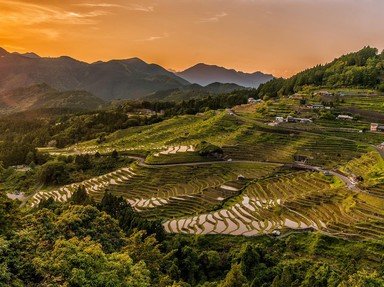Quiz Answer Key and Fun Facts
1. Welcome to Kyoto! After centuries as Japan's Imperial capital, the city is packed with some of the most beautiful and enduring sights of Old Japan. Yet we'll be arriving in very modern style, on a shinkansen to the heart of town. How and where are we getting into Kyoto?
2. We'll begin by visiting Kyoto Gosho, the Imperial Palace. Have your passports ready: to join the tours run by the Imperial Household Agency, you'll need to fill out a short application. Luckily, the gardens and architecture make it worth the fuss! Is Kyoto Gosho still used as an imperial residence?
3. Any visit to Kyoto requires extensive temple touring, and ours will be no exception. As we travel through the city, you'll notice a distinctive gate outside of many shrines. Usually painted a vivid reddish-orange, it consists of two round columns supporting a pair of crossbars: the lower one is straight, and the upper one curves gently toward the sky. What is the name of this type of gate?
4. The Golden Pavilion, a Zen temple building, is one of the most iconic sites in the city. Covered in gold leaf and topped with a golden phoenix, it sits peacefully by a large, still pond, surrounded by trees and casting a shining reflection. But this is no ancient temple; instead, it's a replica. What happened to the original Golden Pavilion in 1950?
5. We'll head south next, and go back in time. Cross a moat and pass through the gate in a high defensive wall, and you're in Nij˘-j˘, a castle of great beauty and palpable power. Behind a second defensive wall is the 17th-century keep, where the de facto rulers of Japan stayed whenever they visited from their capital at Edo. What was the title held by these men, whose dynasty lasted from 1603 until the Meiji Restoration of 1867?
6. Let's go further south to Sanjűsangend˘, a Buddhist temple famous for its statuary. In addition to 28 guardian figures and one enthroned deity, a thousand life-size cypress statues stand in rows in a long wooden hall. These statues, each said to have a thousand arms, depict what bodhisattva of mercy and compassion?
7. Kiyomizu-dera, a Buddhist temple complex, is perched on a steep hillside with a fantastic view of eastern Kyoto. Its three-story pagoda, great hall, smaller shrines and winding pathways are framed by cherry trees. Beneath the hall, at the base of the hill, is the natural formation that gives the temple its name. What is it?
8. Continuing northeast, we'll move on now to the beautiful Nanzen-ji complex, a group of gardens and temple buildings in the southeastern part of Kyoto. One of Nanzen-ji's highlights is a traditional type of garden, the karesansui, where natural landscapes are represented by careful arrangements of what types of object?
9. We'll have some time in the early evening to stroll down the Path of Philosophy, a pleasant walk by the side of a canal. We'll walk the whole length of the path, from Nanzen-ji to Ginkaku-ji (the Silver Pavilion), but you should take some time to explore the smaller temples along the way. In spring, this walk is a beautiful way to appreciate the sakura. What type of flowering tree lines the walk?
10. Our tour ends in a small and beautiful historic district, where traditional wooden buildings and tea houses line a street lit at night by paper lanterns. Geiko - "women of art," called "geisha" elsewhere in Japan - can be seen in the street in the evenings, beautifully dressed and made up as they head to their appointments. Through which Kyoto neighborhood are we wandering?
Source: Author
CellarDoor
This quiz was reviewed by FunTrivia editor
gtho4 before going online.
Any errors found in FunTrivia content are routinely corrected through our feedback system.

